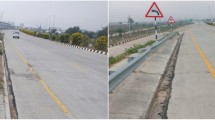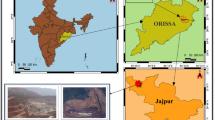Abstract
Drilling and Blasting are still considered to be the most economical method for rock excavation either on surface or underground. The explosive energy, which breaks the rockmass, is not fully utilized for this purpose. Only 20–30% of explosive energy is utilized for fragmenting the rockmass and the rest wasted away in the form of ground vibration, air blast, noise, fly rock, back breaks, etc. Among them, ground vibration is considered to have the most damaging effect. A number of predictor equations have been proposed by various researchers to predict ground vibration prior to blasting. Still, it is difficult to recommend any one predictor for a particular ground condition because ground vibration is influenced by a number of parameters. These parameters are either controllable or non-controllable like blast geometry, explosive types, rock strength properties, joints patterns, etc. In the present paper, an attempt has been made to predict the ground vibration using an Artificial Neural Network incorporating large number of parameters, which affect the ground vibration. Results are also compared with the values obtained from regression analysis and observed field data sets. Finally, it is found that the neural network approach is more accurate and able to predict the value of blast vibration without increasing error with increasing number of inputs and non-linearity among these.
Similar content being viewed by others
References
N.R. Ambraseys A.J Hendron (1968) Dynamic behavior of rock masses, rock mechanics K.G. Stagg O.C. Zeinkiewicz (Eds) Engineering Practice John Wiley and Sons Inc. London 203–227
H. Demuth M. Beale (1994) Neural Network Toolbox User’s Guide Mathworks Inc. MA
Dick, R., Fletcher, L.R. and Andrea, D.V. (1983) Explosives and Blasting Procedures Manual, US Bureau of Mines, IC. No. 8925
Duvall, W.I. and Fogelson, D.E. (1962) Review of Criteria for Estimating Damages to Residences from Blasting Vibrations, US Bureau of Mines, R.I. 5968
W.L. Fourney R.D. Dick X.J. Wang Y. Wei (1993) ArticleTitleFragmentation mechanisms in crater blasting Int. J. Rock Mech. Min. Sci. Geomech. Abstr 30 413–429
Freeman, A.F. and Skapura, D.M. (2002) Neural Network-algorithms, Applications & Programming Technique, 5th edn. Pearson Education, Asia
A.K. Ghosh A.B. Samaddar (1984) ArticleTitleDesign of surface mine blast Min. Eng. J. Inst. Eng. (I) 52–57
T.N. Hagan B.J. Kennedy (1977) ArticleTitleA practical approach to the reduction of blasting nuisance from surface operation Australian Mining 69 IssueID11 36–46
K. Hornik (1991) ArticleTitleApproximation capabilities of multi layer feed forward networks Neural Networks 4 IssueID2 251–257
Katalopous, S.V. (2002) Understanding Neural Networks and Fuzzy Logic
U. Langefors B. Kihlstrom (1963) The Modern Techniques of Rock Blasting John Wiley and Sons Inc. New York 405
W.S. McCulloh Pitts (1943) ArticleTitleLogical calculus of ideas immanent in nervous activity Bull. Math. Biophys. 5 115–133
F. Meulenkamp M.A. Grima (1999) ArticleTitleApplication of neural network for prediction of unconfined compressive strength from equitop hardness Int. J. Rock Mech. Mining Sci. 36 29–39
Nichols, H.R., Johnson, C. and Duvall, W.I. (1971) Blasting Vibrations and their Effects on Structures. U.S. Bureau of Mines Bulletin 656, 105
P. Pal Roy (1991) ArticleTitlePrediction and control of ground vibrations due to blasting Colliery Guardian 239 IssueID7 210–215
Siskid, D.E., Stagg, M.S., Kopp, J.W. and Dowding, C.H. (1980) Structure Response Produced by Ground Vibration from Surface Mine Blasting. U.S. Bureau of Mines report RI 8507
Singh, T.N., Amit, P., Saurabh, P. and Singh, P.K. (2002) Prediction of explosive charge for efficient mining operation, Rock Eng. Problems and approaches in Underground Construction, South Korea, pp. 777–785
Singh, T.N., Singh, A. and Singh, C.S. (1994) Prediction of ground vibration induced by blasting, Ind. Min. Eng Jol., 31–34
K. Ramchandar T.N. Singh (2001) ArticleTitleA Computational approach for prediction of rock fragmentation Min. Eng. Jol. 3 IssueID4 16–25
Werbos, P.J. (1974) Beyond regression: new tools for prediction and analysis in the behavioral science, Ph. D. Thesis, Harvard University, Cambridge, M.A.
Wiss, J.F. and Linehan, P. (1978) Control of Vibration and Blast Noise from Surface Coal Mining. US Bureau of Mines, Research Report 103(1), 79, Washington, DC
Author information
Authors and Affiliations
Corresponding author
Rights and permissions
About this article
Cite this article
Singh, T.N., Singh, V. An intelligent approach to prediction and control ground vibration in mines. Geotech Geol Eng 23, 249–262 (2005). https://doi.org/10.1007/s10706-004-7068-x
Received:
Revised:
Accepted:
Issue Date:
DOI: https://doi.org/10.1007/s10706-004-7068-x




